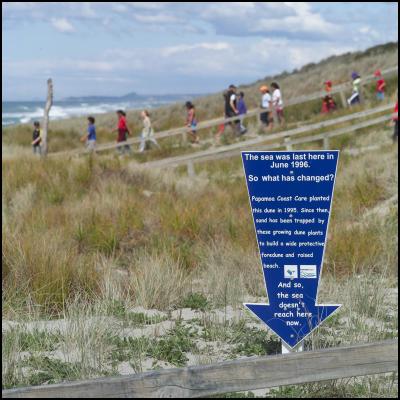Coast Care work reverses a century of dune abuse
MEDIA RELEASE
Coast Care work reverses a century of dune abuse

Click for big version
CAPTION: Coast Care work at Papamoa.
For immediate release: Monday 5 April
2004
Nine years of planting by volunteers has “reversed
the consequences of 100 years of dune abuse” in the region,
according to a major review of the Coast Care Bay of Plenty
programme.
Coast Care coordinator Greg Jenks says native dune plants that were planted several years ago are now consistently trapping sand, restoring the dunes and improving their ability to withstand storms. “There are many sites like that now,” he says. They include Mount Maunganui, Waihi Beach north, Papamoa, Matata, Coastlands and Bryan’s Beach.
In the review, presented recently to Environment Bay of Plenty’s operational services committee, Mr Jenks attributes the programme’s success to its structural concept. Coast Care BOP is “a genuine partnership” between Environment Bay of Plenty, district councils, and Department of Conservation, he says. These agencies work with local community members who take an active role in managing their own beaches.
Two fulltime staff, Mr Jenks and Suzy O’Neill, support the region’s Coast Care groups. “We make sure people are well informed and that their volunteer enthusiasm is not dampened by bureaucratic processes.”
This avoids “the bureaucracy of distance” that is a problem for a similar Australian project. “Our system of simple management provides the best benefit for the coastal environment, and the people who make it all possible: the community volunteers who are passionate about their beaches.”
Mr Jenks says Coast Care’s achievements are “a testament to the vision” of those who initiated the programme. “The sheer scale of human-induced damage to dunes means that their reversal is beyond the resources of any one group. So the partnership between agencies and communities has hastened restoration at a rate beyond anything that would have been possible without the willing cooperation of all these partners.”
Coast Care BOP is now recognised both regionally and nationally for “getting the job done”, he says. He hopes regions without existing Coast Care programmes will consider using the concept too. “The restoration of dunes and their intimately associated beaches has immense recreation and financial benefits for all who treasure our beautiful and dynamic coastline,” he says.
At the moment, 25 groups of Coast Care volunteers operate along the 350kms of the region’s coastline from Waihi Beach to Cape Runaway. A database lists about 900 members who regularly receive information about projects and events. Last year Coast Care agencies provided 36,000 native dune plants, all planted by community volunteers. About 200,000 plants have been planted in total over the last nine years.
ENDS


 Gordon Campbell: On Fast Track Powers, Media Woes And The Tiktok Ban
Gordon Campbell: On Fast Track Powers, Media Woes And The Tiktok Ban Family First: Just 1 In 6 Oppose ‘Three Strikes’ - Poll
Family First: Just 1 In 6 Oppose ‘Three Strikes’ - Poll Labour Party: Budget Blunder Shows Nicola Willis Could Cut Recovery Funding
Labour Party: Budget Blunder Shows Nicola Willis Could Cut Recovery Funding  Government: Urgent Changes To System Through First RMA Amendment Bill
Government: Urgent Changes To System Through First RMA Amendment Bill Peace Movement Aotearoa: Global Military Spending Increase Threatens Humanity And The Planet
Peace Movement Aotearoa: Global Military Spending Increase Threatens Humanity And The Planet Government: To Introduce Revised Three Strikes Law
Government: To Introduce Revised Three Strikes Law Labour Party: Environmental Protection Vital, Not ‘Onerous’
Labour Party: Environmental Protection Vital, Not ‘Onerous’


